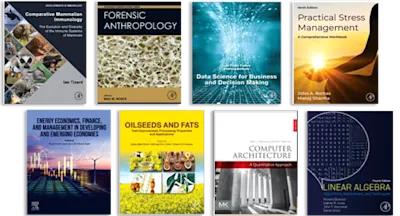
Practical Digital Libraries
Books, Bytes, and Bucks
- 1st Edition - September 17, 1997
- Imprint: Morgan Kaufmann
- Author: Michael Lesk
- Language: English
- Hardback ISBN:9 7 8 - 1 - 5 5 8 6 0 - 4 5 9 - 9
- eBook ISBN:9 7 8 - 0 - 0 8 - 0 5 1 4 3 7 - 6
A digital library is not merely a collection of electronic information. It is an organized and digitized system of data that can serve as a rich resource for its user community. Th… Read more
Purchase options

A digital library is not merely a collection of electronic information. It is an organized and digitized system of data that can serve as a rich resource for its user community. This authoritative and accessible guide for librarians and computer scientists explores the technologies behind digital libraries, the choices to be made in building them, and the economic and policy structures that affect them.
The most comprehensive book on the subject, Practical Digital Libraries* offers the most wide-ranging overview of digital libraries currently available* analyzes economic and intellectual issues in the emerging digital environment* shows how text, images, audio, and video can be represented, distributed, used, and collected as forms of knowledge
- Preface1 Evolution of Libraries
- 1.1 Why Digital Libraries?1.2 History and Change1.3 Advantages of Digital Libraries1.4 Rise of Printing and Libraries1.5 Vannevar Bush1.6 Computer Technology
- 1.6.1 Processors1.6.2 Memory Technology1.6.3 Software
- 2.1 Computer Typesetting and Online Databases2.2 Text Formats2.3 Linear Text Searching2.4 Inverted Files2.5 Hash Coding2.6 Other Text Search Issues2.7 Thesauri2.8 Document Conversion2.9 Summary
- 3.1 Scanning and Fax Machines3.2 Image Formats for Scanned Printed Pages3.3 Display Requirements3.4 PostScript, Acrobat, and Reprinting3.5 Indexing Images of Pages3.6 Shared Text/Image Systems3.7 Image Storage vs. Book Storage3.8 Summary
- 4.1 Sound Formats: Vinyl, Tape, and CD4.2 Pictures: GIF and JPEG4.3 Automatic Speech Recognition4.4 Moving Images: MPEG and Motion JPEG4.5 Indexing Images: Motion Segmentation4.6 Summary
- 5.1 Library Classification5.2 Indexing Words and Thesauri5.3 Artificial Intelligence Structures5.4 Hypertext5.5 Vector Models5.6 History-Based Information Resources5.7 New Information Techniques5.8 Summary
- 6.1 Physical Objects: Books and CD-ROMs6.2 Computer Network Technologies
- 6.2.1 Packets vs. Circuits6.2.2 Stars vs. Buses6.2.3 Ethernet6.2.4 Arpanet and Addressing
- 7.1 General Human Factors Considerations7.2 Text Displays: Fonts and Highlighting7.3 Image Displays and Compression Systems
- 7.3.1 Text7.3.2 Speech7.3.3 Images
- 8.1 Traditional Paper Collections8.2 Traditional Preservation Problems: Acid Paper and Perfect Binding8.3 Digitizing Special Collections and Archives8.4 Sharing of Collections among Libraries8.5 New Kinds of Material and Their Durability8.6 Summary and Responsibilities to the Future
- 9.1 Traditional Economics and Economies of Scale9.2 Scholarly Publications Today9.3 Models for Library Funding9.4 Paying for Electronic Information9.5 Access versus Ownership9.6 Importance of Administrative Costs9.7 Electronic Commerce9.8 The Future of Quality Information9.9 Summary
- 10.1 History of Copyright Law10.2 History of Patent Law10.3 Other Legal Risks10.4 National Information Infrastructure Dangers10.5 Intellectual Property Protection
- 10.5.1 Fractional Access10.5.2 Control of Interface10.5.3 Hardware Locks (Dongles)10.5.4 Repositories10.5.5 Steganography10.5.6 Cryptolopes, or Secret Envelopes10.5.7 Special Hardware10.5.8 Economic Approaches10.5.9 Flickering
- 11.1 Information Policy, Not Industrial Policy11.2 United States
- 11.2.1 University of California at Berkeley11.2.2 University of Michigan11.2.3 University of Illinois11.2.4 Stanford University11.2.5 University of California at Santa Barbara11.2.6 Carnegie Mellon University11.2.7 Other U.S. Projects
- 12.1 Dream to Be Realized12.2 Future Roles in Information Handling12.3 Effect of Digital Technology on Universities12.4 Society and Creativity12.5 Public Policy Questions12.6 Projections
- Edition: 1
- Published: September 17, 1997
- Imprint: Morgan Kaufmann
- Language: English
ML
Michael Lesk
Michael Lesk joined the computer science research group at Bell Laboratories after receiving his Ph.D. degree in Chemical Physics in 1969. He went on to manage the computer science research group at Bellcore, where he is now a chief research scientist. He is best known for his work in electronic libraries, but has worked in document production and retrieval software, computer networks, computer languages, and human-computer interfaces as well. Past chair of the Association for Computing Machinery’s special interest groups on Language Analysis and Information Retrieval, Lesk was Senior Visiting Fellow of the British Library in 1987 and is currently Visiting Professor of Computer Science at University College London. Lesk has been recently elected to the US National Academy of Engineering, in recognition of his contributions to UNIX applications, information systems, and digital libraries.